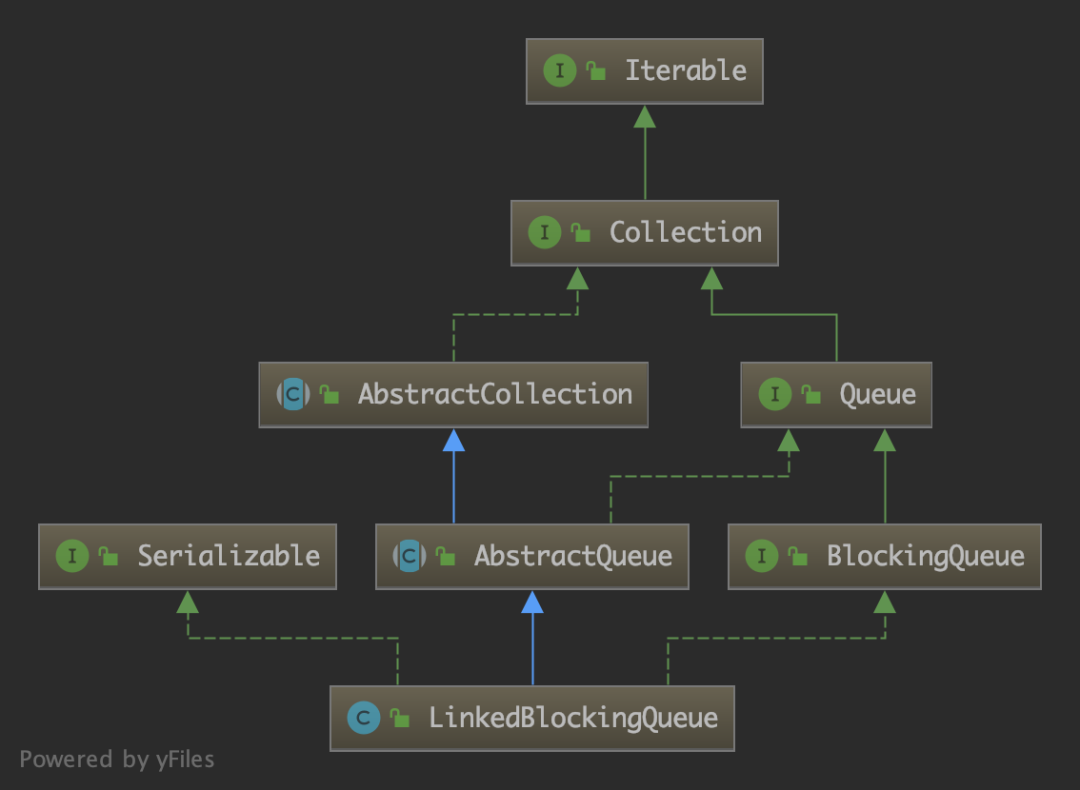概述
前文「JDK源码分析-ArrayBlockingQueue」分析了 ArrayBlockingQueue 的代码实现,LinkedBlockingQueue 也是阻塞队列的实现。与前者不同的是,后者内部是由链表实现的。
LinkedBlockingQueue 的继承结构如下:

下面分析其主要方法的代码实现。
代码分析
LinkedBlockingQueue 内部有一个嵌套类 Node,它表示链表的节点,如下:
static class Node<E> { E item; // 节点元素 Node<E> next; // 后继节点 Node(E x) { item = x; }}
PS: 从 Node 定义可以看出该链表是一个单链表。
主要成员变量
// 链表的容量(若不指定则为 Integer.MAX_VALUE)private final int capacity;// 当前元素的数量(即链表中元素的数量)private final AtomicInteger count = new AtomicInteger();// 链表的头节点(节点元素为空)transient Node<E> head;// 链表的尾结点(节点元素为空)private transient Node<E> last;// take、poll 等出队操作持有的锁private final ReentrantLock takeLock = new ReentrantLock();/** Wait queue for waiting takes */// 出队锁的条件队列private final Condition notEmpty = takeLock.newCondition();// put、offer 等入队操作的锁private final ReentrantLock putLock = new ReentrantLock();/** Wait queue for waiting puts */// 入队锁的条件队列private final Condition notFull = putLock.newCondition();
构造器
LinkedBlockingQueue 有三个构造器,分别如下:
// 构造器 1:无参构造器,初始容量为 Integer.MAX_VALUE,即 2^31-1public LinkedBlockingQueue() { this(Integer.MAX_VALUE);}// 构造器 2:指定容量的构造器public LinkedBlockingQueue(int capacity) { if (capacity <= 0) throw new IllegalArgumentException(); this.capacity = capacity; // 初始化链表的头尾节点 last = head = new Node<E>(null);}// 构造器 3:用给定集合初始化的构造器public LinkedBlockingQueue(Collection<? extends E> c) { // 调用构造器 2 进行初始化 this(Integer.MAX_VALUE); final ReentrantLock putLock = this.putLock; putLock.lock(); // Never contended, but necessary for visibility try { int n = 0; for (E e : c) { if (e == null) throw new NullPointerException(); if (n == capacity) throw new IllegalStateException("Queue full"); // 将集合中的元素封装成 Node 对象,并添加到链表末尾 enqueue(new Node<E>(e)); ++n; } count.set(n); } finally { putLock.unlock(); }}
enqueue 方法如下:
// 将 node 节点添加到链表末尾private void enqueue(Node<E> node) { last = last.next = node;}
主要入队方法:put(E)、offer(E, timeout, TimeUnit)、offer(E)
1. put(E) 代码如下:
public void put(E e) throws InterruptedException { if (e == null) throw new NullPointerException(); // Note: convention in all put/take/etc is to preset local var // holding count negative to indicate failure unless set. int c = -1; // 把 E 封装成 Node 节点 Node<E> node = new Node<E>(e); final ReentrantLock putLock = this.putLock; final AtomicInteger count = this.count; putLock.lockInterruptibly(); try { /* * Note that count is used in wait guard even though it is * not protected by lock. This works because count can *> * out by lock), and we (or some other waiting put) are * signalled if it ever changes from capacity. Similarly * for all other uses of count in other wait guards. */ // 若队列已满,notFull 等待(类比生产者) while (count.get() == capacity) { notFull.await(); } // node 入队 enqueue(node); c = count.getAndIncrement(); // 若该元素添加后,队列仍未满,唤醒一个其他生产者线程 if (c + 1 < capacity) notFull.signal(); } finally { putLock.unlock(); } // c==0 说明之前队列为空,出队线程处于等待状态, // 添加一个元素后,将出队线程唤醒(消费者) if (c == 0) signalNotEmpty();}
signalNotEmpty 方法:
private void signalNotEmpty() { final ReentrantLock takeLock = this.takeLock; takeLock.lock(); try { // 唤醒 notEmpty 条件下的一个线程(消费者) notEmpty.signal(); } finally { takeLock.unlock(); }}
2. offer(E, timeout, TimeUnit):
public boolean offer(E e, long timeout, TimeUnit unit) throws InterruptedException { if (e == null) throw new NullPointerException(); long nanos = unit.toNanos(timeout); int c = -1; final ReentrantLock putLock = this.putLock; final AtomicInteger count = this.count; putLock.lockInterruptibly(); try { while (count.get() == capacity) { // 等待超时,返回 false if (nanos <= 0) return false; nanos = notFull.awaitNanos(nanos); } // 入队 enqueue(new Node<E>(e)); c = count.getAndIncrement(); if (c + 1 < capacity) notFull.signal(); } finally { putLock.unlock(); } if (c == 0) signalNotEmpty(); return true;}
该方法与 put 操作类似,不同的是 put 方法在队列满时会一直等待,而该方法有超时时间,超时后返回 false。
3. offer(E):
public boolean offer(E e) { if (e == null) throw new NullPointerException(); final AtomicInteger count = this.count; // 若队列已满,直接返回 false if (count.get() == capacity) return false; int c = -1; Node<E> node = new Node<E>(e); final ReentrantLock putLock = this.putLock; putLock.lock(); try { // 队列未满,入队 if (count.get() < capacity) { enqueue(node); c = count.getAndIncrement(); if (c + 1 < capacity) // 队列未满,唤醒 notFull 下的线程,继续入队 notFull.signal(); } } finally { putLock.unlock(); } if (c == 0) signalNotEmpty(); return c >= 0;}
入队方法小结
1. put(E): 若队列已满,则等待,无返回值;
2. offer(E, timeout, TimeUnit): 与 put 方法类似,有超时等待和返回值;
3. offer(E): 立即返回,没有循环等待。
常用出队方法:take、poll(timeout, TimeUnit)、poll()、peek()
1. take():
public E take() throws InterruptedException { E x; int c = -1; final AtomicInteger count = this.count; final ReentrantLock takeLock = this.takeLock; takeLock.lockInterruptibly(); try { // 队列为空,notEmpty 条件下的线程等待(消费者) while (count.get() == 0) { notEmpty.await(); } // 从队列头部删除节点 x = dequeue(); c = count.getAndDecrement(); // 若队列不为空,唤醒一个 notEmpty 条件下的线程(消费者) if (c > 1) notEmpty.signal(); } finally { takeLock.unlock(); } // 队列已经不满了,唤醒 notFull 条件下的线程(生产者) if (c == capacity) signalNotFull(); return x;}
dequeue 方法:
private E dequeue() { Node<E> h = head; // 头节点 Node<E> first = h.next; // 头节点的后继节点 h.next = h; // help GC // 后继节点指向自己(从链表中删除) head = first; // 更新头节点 E x = first.item; // 获取要删除节点的数据 first.item = null; // 清空数据(新的头节点) return x;}
signalNotFull:
private void signalNotFull() { final ReentrantLock putLock = this.putLock; putLock.lock(); try { // 唤醒生产者 notFull.signal(); } finally { putLock.unlock(); }}
2. poll(timeout, TimeUnit):
public E poll(long timeout, TimeUnit unit) throws InterruptedException { E x = null; int c = -1; long nanos = unit.toNanos(timeout); final AtomicInteger count = this.count; final ReentrantLock takeLock = this.takeLock; takeLock.lockInterruptibly(); try { // 队列已空 while (count.get() == 0) { // 超时返回 null if (nanos <= 0) return null; nanos = notEmpty.awaitNanos(nanos); } x = dequeue(); // 若队列不空,唤醒一个 notEmpty 条件下的线程(消费者) c = count.getAndDecrement(); if (c > 1) notEmpty.signal(); } finally { takeLock.unlock(); } // 队列不满,唤醒 notFull 条件下的线程(生产者) if (c == capacity) signalNotFull(); return x;}
与 take 方法类似,多了超时等待。
3. poll():
public E poll() { final AtomicInteger count = this.count; // 队列为空,返回 null if (count.get() == 0) return null; E x = null; int c = -1; final ReentrantLock takeLock = this.takeLock; takeLock.lock(); try { // 队列不为空,出队 if (count.get() > 0) { x = dequeue(); c = count.getAndDecrement(); // 该元素出队后,队列仍不为空,唤醒其他消费者 if (c > 1) notEmpty.signal(); } } finally { takeLock.unlock(); } // 队列已经不满,唤醒生产者 if (c == capacity) signalNotFull(); return x;}
4. peek()
public E peek() { if (count.get() == 0) return null; final ReentrantLock takeLock = this.takeLock; takeLock.lock(); try { // 头节点的后继节点 Node<E> first = head.next; if (first == null) return null; else return first.item; } finally { takeLock.unlock(); }}
peek() 方法只返回头节点,并不删除。严格来说该方法并不属于出队操作,只是查询。
出队方法小结
1. take(): 获取队列头部元素,并将其移除,队列为空时阻塞等待;
2. poll(long, unit): 获取队列头部元素,并将其移除,队列为空时等待一段时间,若超时返回 null;
3. poll(): 获取队列头部元素,并将其移除,队列为空时返回 null;
小结
1. LinkedBlockingQueue 是基于单链表的阻塞队列实现,它在初始化时可以指定容量,若未指定,则默认容量为 Integer.MAX_VALUE;
2. 内部使用了 ReentrantLock 保证线程安全;
3. 常用方法:
入队:put, offer
出队:take, poll, peek
LinkedBlockingQueue 与 ArrayBlockingQueue 比较:
1. ArrayBlockingQueue 使用单个锁,可以指定是否公平;而 LinkedBlockingQueue 内部使用了两个锁:putLock 和 takeLock,都是非公平锁。
2. 入队出队区别
入队时,LinkedBlockingQueue 会判断当前元素入队后,队列是否已满,若未满,则唤醒其他生产者线程;而入队后,当队列之前为空时才唤醒其他消费者线程。ArrayBlockingQueue 则是每次入队都会唤醒消费者线程。
出队时,LinkedBlockingQueue 会判断当前元素出队后,队列是否已空,若未空,则唤醒其他消费者线程;而出队后,当队列之前为满时才唤醒其他生产者线程。ArrayBlockingQueue 则是每次出队都会唤醒生产者线程。
Stay hungry, stay foolish.
